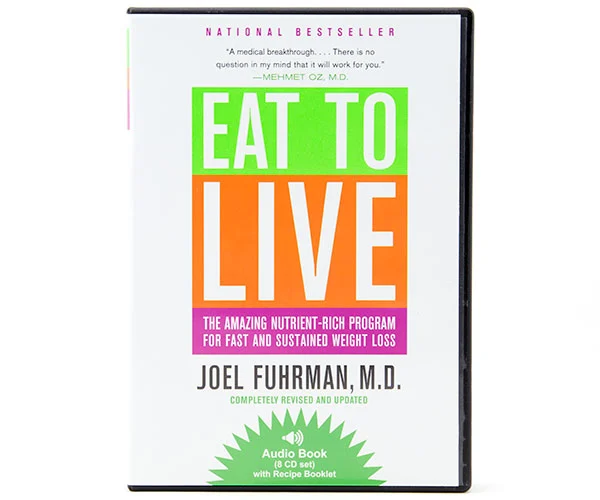Don’t Live to Eat
Eat to Live or Eating to Live for many of us can be a big switch. Especially since eating can be emotional for many of us. I read a lot and always enjoy learning something new. The three books I read recently include the book by Dr. Morter on pH Balancing, which I wrote about last month. I read the book “The China Study”, then I read the book “Your Health Your Choice”, and then I read the book “Eat to Live”. Each book basically concluded the same thing.
These books began discussing three very different subjects. “The China Study” was an exploration about what and why do certain people live longer. “Your Health Your Choice” was about pH balancing and how the food we eat affects our pH. Eat to Live is about maintaining a healthy weight and becoming healthier, even reversing disease. Each book drew the same conclusion, we need to eat more fruits and vegetables and less processed food.
Give Eat to Live a Try
If you are like me, we are all aging and don’t quite look the way we used to or the way we want to, even if we are the same weight. With a recent gain of 10 pounds that I would like to lose, I have tried many diets. It’s hard to count calories and it is uncomfortable when you feel starved. I do agree that before you can modify your diet, you should write down everything you eat for a week so you can determine when and why you might be overeating. After reading the book Eat to Live and putting into action Dr. Fuhrman’s program of eating Nutrient Dense Foods.
I lost 4 1/2 lbs in one week and wasn’t’ even hungry. Also, I didn’t quite put into effect all of his habits. Cutting down my portion size on the amount of fish and meat I ate during the week and giving up cheese and dairy were two habits I gave up. For me, the dietary changes were not very drastic as they would be for some of you because I do not eat a lot of refined and processed foods, but it was definitely effective! Not only does Eat to Live benefit you for weight loss it has also helped many get healthy and reverse disease. I am a firm believer that aging gracefully requires eating to live.
The following outline are highlights of the basics of Dr. Fuhrman’s Nutritarian Lifestyle Diet
Eat Good Food
With Dr. Fuhrman’s “Eat to Live” program there is no food deprivation. You set your own pace and eat what you want in moderation. Dr. Fuhrman believes that the more Nutrient Dense Food you eat, the more your cravings and addictions go away and the quicker you lose weight. Junk food or refined processed foods have empty calories and are deficient in nutrients and fiber. When food is deficient in fiber sugar absorption is accelerated which is one of the major contributers to our #1 Health Problem in the US – OBESITY!
According to Dr. Fuhrman, the evidence speaks for itself, thinness and longevity go hand in hand and obesity leads to a shorter life span. Women with a waist circumference greater than 35 and Men with a waist circumference greater than 40 are setting themselves up for disease. The CDC says obesity contributes to over 30 conditions. The current American diet is the culprit for America’s high rate of heart disease and cancer and a direct correlation exists between these two diseases and the amount of unrefined plant food we eat.
Fruits and Vegetables
Fruits and vegetables are very good for us. Some fruits can be high in carbohydrates, but due to their high fiber content their sugar absorption is much slower. The fiber content along with its sugar content should not lead to peaks and valleys with blood sugar levels. Believe it or not veggie also contain a lot of protein and often more protein than meat. Fruits and Veggies also contain a certain amount of fat and are very high in Phytochemicals (nutrients like beta-carotene that naturally occur in plants). Fruits and Veggies are utilized by the body because they offer our bodies a lot of nutrition.
Our Health
Let’s face it, we can’t buy our health. We have to earn it. As much as I would love to think there is a magic beauty pill out there, there isn’t an easy way of staying healthy and thin. It is our responsibility and we must concentrate on what we are eating and drinking and focus on eating nutrient dense foods like fruits, vegetables, whole grains, and nuts.
Vegetarians and Vegans
Some people are Vegetarians and some people are Vegans. Dr. Fuhrman stresses nutrient dense foods in his book and that you should strictly limit your meat and fish consumption to so many ounces per week, but also mentions that if you do not eat meat or fish you definitely need to supplement with B12. He also explains that vegetarians are not necessarily healthy. Some not so strict vegetarians eat a lot of dairy products, cheese, breads, and sweets. This type of diet, although vegetarian, is also lacking in nutrients.
What is Nutrient Density
Nutrient Density is H=N/C. Health is equal to Nutrients divided by calories. the higher the nutrient density the better the food is for us. Dr. Fuhrman states in his book that you should shoot for eating 1 lb of raw leafy green vegetables and 1 lb of solid green vegetables per day. Leafy and solid green vegetables have the highest nutrient density. Below are some food types in order of the highest nutrient density to the lowest:
- Raw leafy green vegetables – romaine and leaf lettuce, kale, spinach
- Solid green vegetables – asparagus, artichokes, bok choy, broccoli, brussel sprouts, cabbage, celery, cucumber, peas, peppers, snow peas, string beans, zucchini
- Non-green, non-starchy vegetables – beets eggplants, onions, tomatoes, mushrooms, yellow and red peppers,
- Beans/Legumes – red kidney beans, chickpeas, pinto beans, cow peas, navy beans, lentils, white beans, lima beans, pigeon peas, black-eyed peas, black beans
- Fresh Fruits – apples, apricots, bananas, blackberries, blueberries, cantaloupes, grapes, kiwis, mangos, all melons, peaches, pears, persimmons, pineapples, plums raspberries, strawberries, tangerines, watermelon
- Starchy Vegetables – white potatoes, sweet potatoes, butternut squash, acorn squash, winter squash, parsnips, pumpkins, turnips, corn, carrots, chestnuts
- Whole Grains – barley buckwheat, millet, oats, brown rice, wild rice, quinoa
- Raw Nuts and Seeds – almonds, cashews, filberts, macadamias, pecans, pine nuts, pistachios, pumpkin seeds, sunflower seeds
- Fish
- Fat-free Dairy
- Wild meats and fowl
- Eggs
- Red Meat
- Full – fat dairy
- Cheese
- Refined Grains (white flour)
- Refined Oils
- Refined Sweets
The object of Dr. Fuhrman’s “Eat to Live” Plan is to focus on eating to live and consume all you want of high nutrient density foods.
The Eat to Live Life Plan
Many people closely following the “Eat to Live” plan have lost 20 lbs or more in 6 weeks. These individuals shot for the consumption of a pound per day of green leafy veggie and solid green vegetables, a minimum of 4 servings of fruit, no more than 1 cup of beans, no more than one serving of whole grains or starchy vegetables per day. Dr. Fuhrman recommends that no meat is better but its your plan, you can do what I do and use your meat as a topping not a main dish. I do feel this book can really help an individual get started, however, healthy living is more than diet. Start creating a healthier lifestyle as well.
Dr. Fuhrman has a lot of recipes and suggestions, but you are the one who needs to make the changes. I was so excited about this book because it is very easy to determine what you can and can not eat and you don’t have to count fat, carbohydrates, or proteins – just eat nutrient dense foods!
My second favorite resource for converting to a healthier way of eating is the movie Joe Cross did called “Fat, Sick and Nearly Dead”. Joe shares his movie at no cost. Both Eat ot Live and the movie Fat Sick and Nearly Dead gave me a different perspective on how I look at food. Although I am not vegan or vegetarian, I do follow a highly nutrient dense diet full of plants to maintain my health.
References: Eat to Live, Dr. Joel Fuhrman

